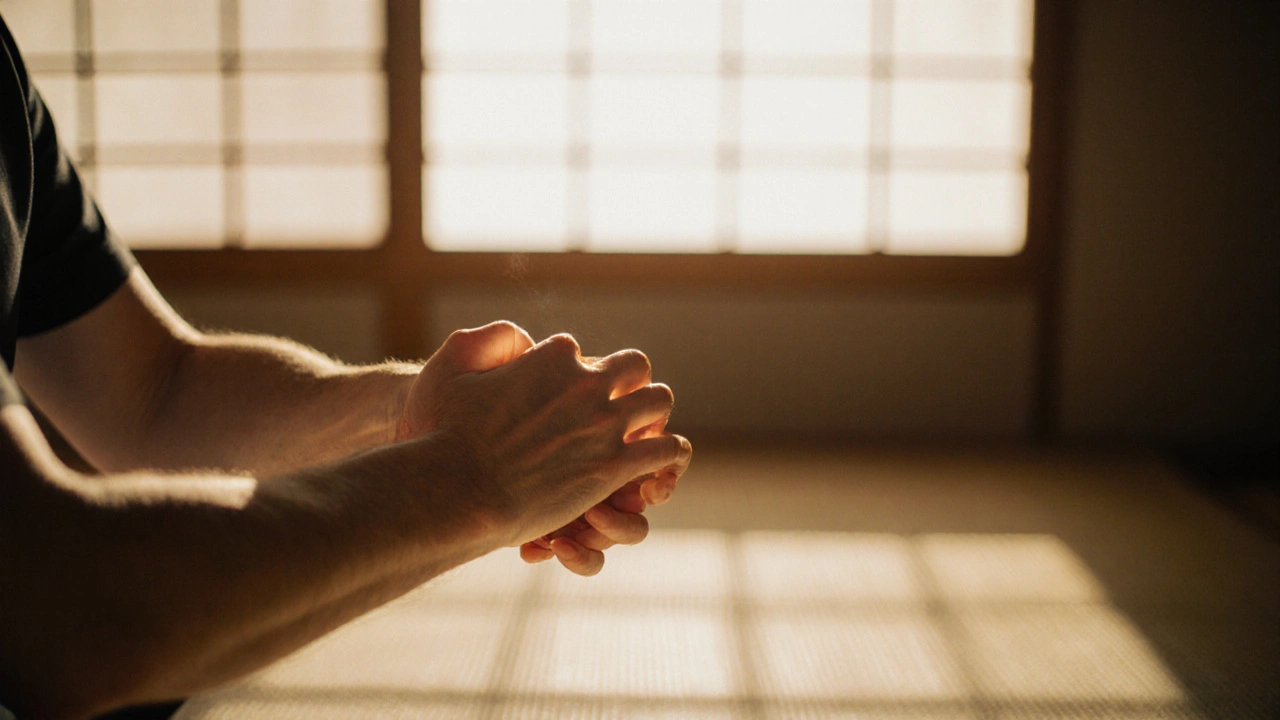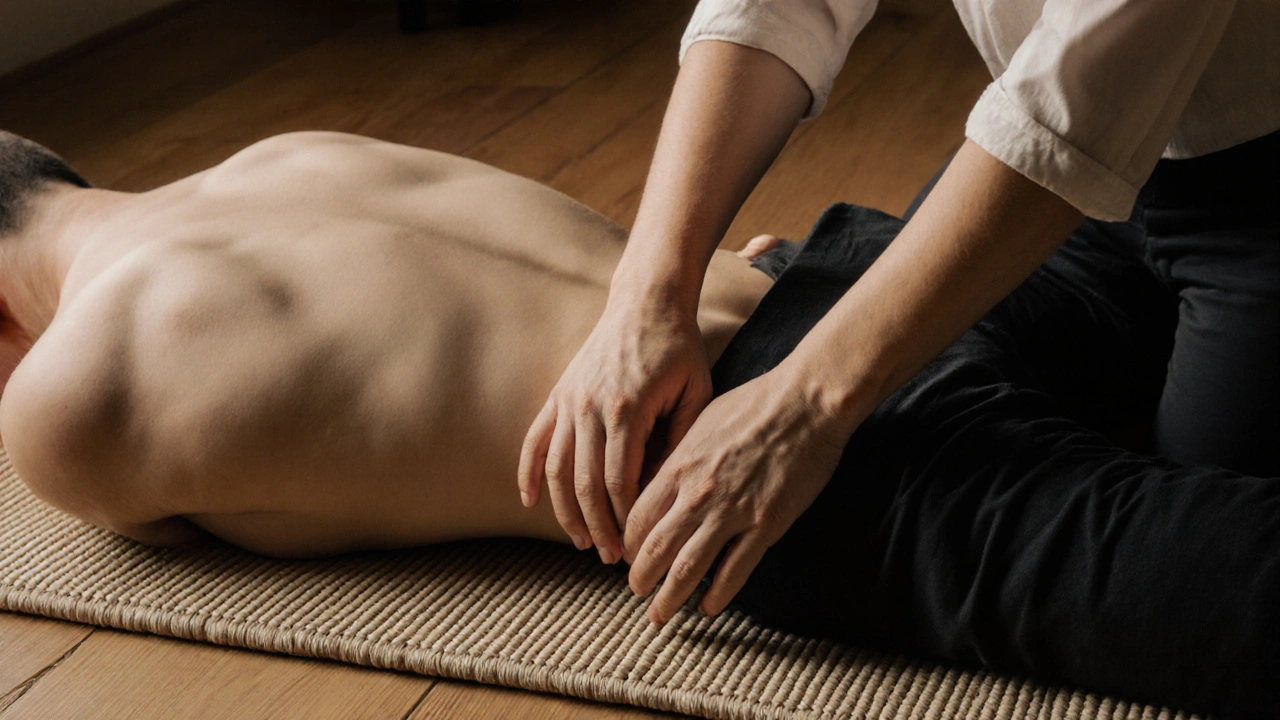Stress Balance Calculator
Assess your current stress levels and see how Shiatsu can help restore balance in your body's energy system.
How Are You Feeling Today?
Shiatsu works by gently applying pressure to energy pathways to help your body restore balance. The University of Tokyo found that just 20 minutes of shiatsu can lower cortisol levels by 27%.
How does Shiatsu compare to other therapies? Here's what the research shows:
| Feature | Shiatsu | Swedish Massage | Deep Tissue | Acupuncture |
|---|---|---|---|---|
| Pressure Type | Static, rhythmic finger and palm pressure | Long strokes, kneading | Intense, focused friction | Needles inserted into skin |
| Clothing | Fully clothed | Undressed, draped | Undressed, draped | Fully clothed |
| Primary Goal | Balance energy flow | Relax muscles | Break down scar tissue | Stimulate nerve pathways |
| Duration of Effect | Days to weeks, cumulative | Hours to one day | Hours to days | Hours to days |
| Best For | Chronic stress, emotional tension, fatigue | General relaxation | Sports injuries, chronic pain | Acute pain, inflammation |
Shiatsu isn’t just another massage. It’s a quiet, intentional practice that’s been healing people in Japan for over a century - not by rubbing muscles, but by listening to them with your hands.
What Shiatsu Really Is
Shiatsu, which means "finger pressure" in Japanese, is a form of bodywork that uses thumb, palm, and sometimes elbow pressure along energy pathways called meridians. These pathways are the same ones used in traditional Chinese medicine and acupuncture. But unlike acupuncture, shiatsu doesn’t use needles. It uses your body’s own response to touch.
The goal isn’t to relax you (though that often happens). It’s to restore balance. When your energy - called ki in Japanese - flows smoothly, your body heals itself. When it’s blocked, you feel tired, tense, or achy. Shiatsu practitioners don’t guess where the blockage is. They feel for it. The pressure isn’t hard. It’s deep, steady, and patient. Too much force and you shut down. Too little and you don’t connect.
How It Works: More Than Just Pressure
Shiatsu works because your nervous system responds to consistent, grounded touch. Studies from the University of Tokyo in 2023 showed that 20 minutes of shiatsu lowered cortisol levels by an average of 27% in participants with chronic stress. That’s not magic. It’s biology. Your parasympathetic nervous system - the one that says "rest and digest" - wakes up when pressure is applied slowly and rhythmically.
Practitioners don’t just press random spots. They follow the 12 main meridians connected to organs: liver, heart, lungs, kidneys, spleen, and more. Each meridian has points where energy gathers. Pressing those points gently signals the body to release tension, improve circulation, and reset its internal rhythm.
One woman in Osaka, who had been struggling with insomnia for five years, started weekly shiatsu sessions. After eight weeks, she stopped taking sleep aids. She didn’t feel "relaxed." She felt aligned. That’s the difference. Shiatsu doesn’t numb pain. It helps your body remember how to heal.
What to Expect in a Session
You’ll lie fully clothed on a mat on the floor. No oils, no undressing, no loud music. Just quiet. The practitioner will begin by placing their hands on your back, feet, or shoulders - wherever the tension feels deepest. You might feel warmth, tingling, or a subtle pulse under their fingers. That’s your body responding.
A typical session lasts 60 to 90 minutes. You won’t be asked to rate your pain on a scale of 1 to 10. The practitioner observes how your breath changes, how your muscles soften, where your body resists pressure. They adjust in real time. If you flinch, they lighten up. If you sigh, they hold longer.
Some people feel tired afterward. Others feel energized. Both are normal. Your body is reorganizing. Don’t rush into coffee or your phone right after. Drink water. Sit quietly. Let the shift settle.

Shiatsu vs. Other Bodywork Therapies
It’s easy to confuse shiatsu with Swedish massage, deep tissue, or even acupuncture. But the differences matter.
| Feature | Shiatsu | Swedish Massage | Deep Tissue | Acupuncture |
|---|---|---|---|---|
| Pressure Type | Static, rhythmic finger and palm pressure | Long strokes, kneading | Intense, focused friction | Needles inserted into skin |
| Clothing | Fully clothed | Undressed, draped | Undressed, draped | Fully clothed |
| Primary Goal | Balance energy flow | Relax muscles | Break down scar tissue | Stimulate nerve pathways |
| Duration of Effect | Days to weeks, cumulative | Hours to one day | Hours to days | Hours to days |
| Best For | Chronic stress, emotional tension, fatigue | General relaxation | Sports injuries, chronic pain | Acute pain, inflammation |
Shiatsu is slower than Swedish. Less aggressive than deep tissue. And it doesn’t pierce the skin like acupuncture. It’s not about fixing one problem. It’s about helping your whole system find its rhythm again.
Who Benefits Most
Shiatsu isn’t a cure-all. But it’s especially powerful for people who feel stuck - emotionally or physically.
- People with chronic stress or burnout - especially those who can’t shut their minds off
- Those with tension headaches or neck stiffness from sitting at desks all day
- People recovering from illness or surgery who need gentle support
- Anyone who feels "numb" - emotionally disconnected or physically drained
It’s not ideal for acute injuries like sprains or fractures. And if you have osteoporosis, severe blood disorders, or are pregnant without prior experience, talk to your doctor first. But for most people, it’s safe, non-invasive, and deeply calming.
Why It Feels So Different
Most therapies focus on what’s broken. Shiatsu focuses on what’s whole. You’re not a problem to be fixed. You’re a system trying to rebalance itself - and the practitioner is just helping it remember how.
That’s why people come back. Not because it feels good in the moment (though it often does). But because they start noticing things: they sleep deeper. They don’t snap at their partner. They breathe easier when they walk into a crowded room. These aren’t side effects. They’re signs your nervous system is recalibrating.
One man in Melbourne, a software developer who’d been on antidepressants for seven years, started shiatsu after his therapist suggested it. He didn’t expect miracles. But after six months, he cut his medication in half. He didn’t feel "happy." He felt present. That’s the quiet power of shiatsu.

How to Find a Good Practitioner
Not everyone who calls themselves a shiatsu therapist is trained properly. Look for someone certified by a recognized body like the Asian Bodywork Therapy Association or the Japan Shiatsu College. In Australia, many practitioners are registered with the Australian Register of Shiatsu Practitioners.
Ask: "How long have you trained?" and "Do you follow the traditional meridian system?" If they say "I learned online in a weekend," walk away. Real shiatsu takes 500+ hours of training - plus supervised clinical practice.
Don’t be afraid to try one session. If you feel worse after, or the practitioner pushes too hard, it’s not for you. But if you feel lighter, quieter, and more grounded - even just a little - you’ve found something rare.
Can You Do Shiatsu Yourself?
You can’t fully replicate a professional session - but you can bring its principles into your daily life.
- Press gently on the space between your thumb and index finger (LI4 point) for 30 seconds when you feel stress rising.
- Use your knuckles to apply slow pressure along your spine, from base to neck, while lying on a foam roller.
- Place your palms on your lower abdomen (just below your navel) and breathe into them for two minutes before bed.
These aren’t magic fixes. But they’re reminders. Your body knows how to heal. You just need to give it space - and steady pressure - to do it.
Shiatsu Is a Conversation, Not a Treatment
It’s easy to think of healing as something done to you. Shiatsu flips that. It’s not about fixing. It’s about listening. The practitioner listens with their hands. You listen with your body. And together, you remember what balance feels like.
In a world that’s always pushing - for more productivity, more speed, more output - shiatsu is the quiet rebellion. It says: Slow down. Your body already knows how to heal. You just have to stop interrupting it.

